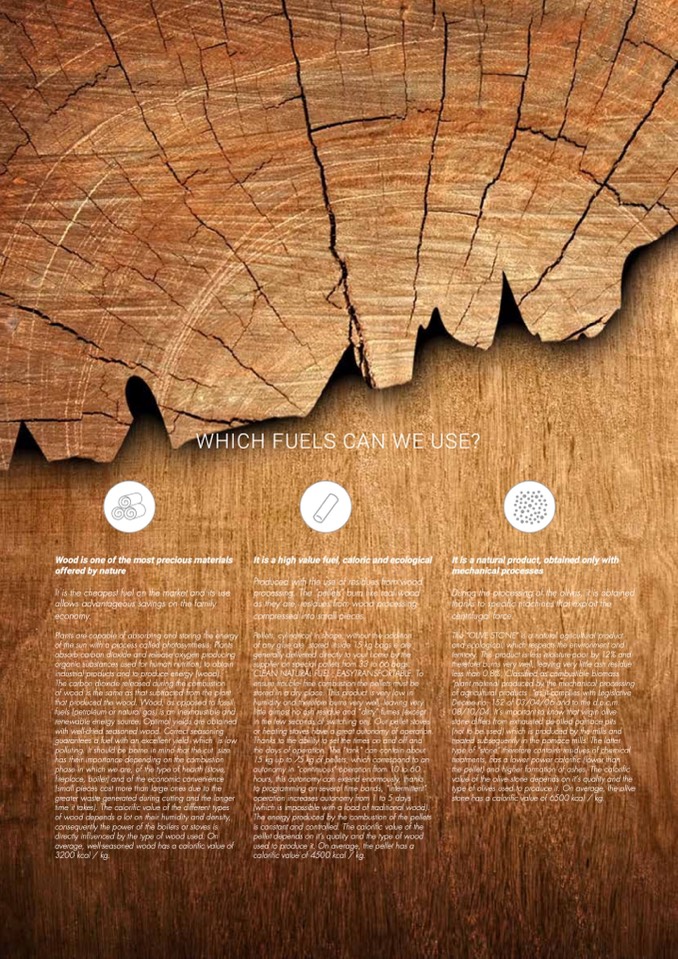
WHICH FUELS CAN WE USE?
Wood is one of the most precious materials
offered by nature
It is the cheapest fuel on the market and its use
allows advantageous savings on the family
economy.
Plants are capable of absorbing and storing the energy
of the sun with a process called photosynthesis. Plants
absorb carbon dioxide and release oxygen producing
organic substances used for human nutrition, to obtain
industrial products and to produce energy (wood).
The carbon dioxide released during the combustion
of wood is the same as that subtracted from the plant
that produced the wood. Wood, as opposed to fossil
fuels (petroleum or natural gas) is an inexhaustible and
renewable energy source. Optimal yields are obtained
with well-dried seasoned wood. Correct seasoning
guarantees a fuel with an excellent yield which is low
polluting. It should be borne in mind that the cut size
has their importance depending on the combustion
phase in which we are, of the type of hearth (stove,
fireplace, boiler) and of the economic convenience
(small pieces cost more than large ones due to the
greater waste generated during cutting and the longer
time it takes). The calorific value of the different types
of wood depends a lot on their humidity and density,
consequently the power of the boilers or stoves is
directly influenced by the type of wood used. On
average, well-seasoned wood has a calorific value of
3200 kcal / kg.
It is a high value fuel, caloric and ecological
Produced with the use of residues from wood
processing. The “pellets” burn like real wood
as they are, residues from wood processing
compressed into small pieces.
Pellets, cylindrical in shape, without the addition
of any glue are stored inside 15 kg bags e are
generally delivered directly to your home by the
supplier on special pallets from 33 to 66 bags.
CLEAN NATURAL FUEL , EASYTRANSPORTABLE. To
ensure trouble- free combustion the pellets must be
stored in a dry place. This product is very low in
humidity and therefore burns very well, leaving very
little almost no ash residue and “dirty” fumes (except
in the few seconds of switching on). Our pellet stoves
or heating stoves have a great autonomy of operation.
Thanks to the ability to set the times on and off and
the days of operation. The “tank” can contain about
15 kg up to 75 kg of pellets, which correspond to an
autonomy in “continuous” operation from 10 to 60
hours, this autonomy can extend enormously, thanks
to programming on several time bands, “intermittent”
operation increases autonomy from 1 to 5 days
(which is impossible with a load of traditional wood).
The energy produced by the combustion of the pellets
is constant and controlled. The calorific value of the
pellet depends on it’s quality and the type of wood
used to produce it. On average, the pellet has a
calorific value of 4500 kcal / kg.
It is a natural product, obtained only with
mechanical processes
During the processing of the olives, it is obtained
thanks to specific machines that exploit the
centrifugal force.
The “OLIVE STONE“ is a natural agricultural product
and ecological, which respects the environment and
territory. This product is less moisture-poor by 12% and
therefore burns very well, leaving very little ash residue
less than 0.8%. Classified as combustible biomass
“plant material produced by the mechanical processing
of agricultural products “as it complies with Legislative
Decree no. 152 of 03/04/06 and to the d.p.c.m.
08/10/04. It’s important to know that virgin olive
stone differs from exhausted de-oiled pomace pits
(not to be used) which is produced by the mills and
treated subsequently in the pomace mills. The latter
type of “stone” therefore contains residues of chemical
treatments, has a lower power calorific (lower than
the pellet) and higher formation of ashes. The calorific
value of the olive stone depends on it’s quality and the
type of olives used to produce it. On average, the olive
stone has a calorific value of 6500 kcal / kg.
9

